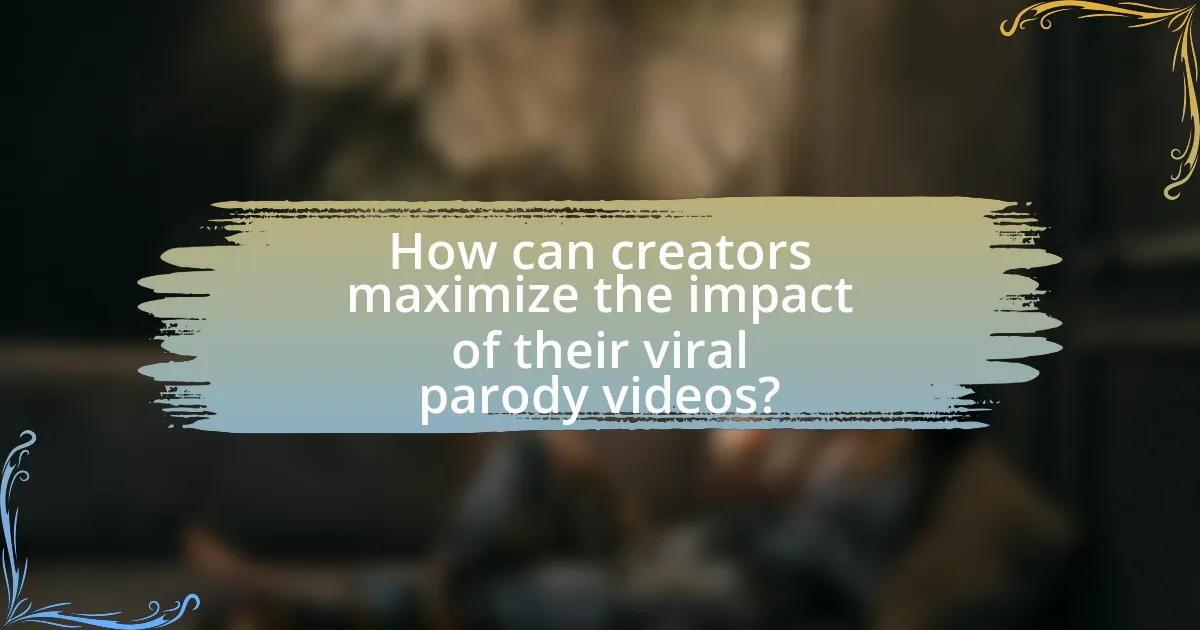Viral parody videos are humorous reinterpretations of existing media that achieve widespread popularity through social sharing. This article analyzes the factors contributing to their success, including humor, relatability, cultural relevance, and the role of social media platforms in enhancing visibility. It distinguishes viral parody videos from traditional parody content by highlighting their rapid dissemination and audience engagement through current trends. Additionally, the article explores effective strategies for creators to maximize impact, avoid common pitfalls, and leverage audience feedback for improvement, ultimately providing insights into the dynamics of viral content in the digital age.

What are Viral Parody Videos?
Viral parody videos are humorous reinterpretations of existing media, often music or film, that gain widespread popularity through social sharing. These videos typically mimic the original content while adding comedic elements, satire, or social commentary, making them relatable and entertaining to a broad audience. The success of viral parody videos can be attributed to their ability to resonate with viewers, leverage current trends, and utilize platforms like YouTube and social media for rapid dissemination, leading to millions of views and shares.
How do viral parody videos differ from traditional parody content?
Viral parody videos differ from traditional parody content primarily in their distribution and audience engagement. Viral parody videos leverage social media platforms and algorithms to reach a wider audience rapidly, often resulting in millions of views within a short time frame. In contrast, traditional parody content typically relies on established media channels, such as television or film, which may limit its immediate reach and engagement. For example, viral videos often utilize humor that resonates with current trends or memes, making them more shareable and relatable, while traditional parodies may focus on broader cultural references that do not capitalize on real-time social dynamics. This difference in approach contributes to the rapid spread and popularity of viral parody videos compared to their traditional counterparts.
What elements contribute to the virality of parody videos?
The elements that contribute to the virality of parody videos include humor, relatability, cultural references, and shareability. Humor is essential as it engages viewers and encourages them to share the content with others, leading to increased visibility. Relatability allows audiences to connect with the content, making it more likely to resonate and be shared. Cultural references tap into current trends or popular media, enhancing the video’s relevance and appeal. Shareability is driven by the video’s ability to evoke strong emotional reactions, prompting viewers to distribute it across social media platforms. Studies show that videos that elicit laughter and emotional responses are more likely to be shared, reinforcing the importance of these elements in achieving virality.
Why do audiences gravitate towards parody videos?
Audiences gravitate towards parody videos primarily because they provide humor through satire and relatable content. Parody videos often mimic popular culture, allowing viewers to engage with familiar themes in a comedic context, which enhances enjoyment. Research indicates that humor is a key driver of social sharing; for instance, a study published in the journal “Computers in Human Behavior” found that humorous content is more likely to be shared on social media platforms, increasing its reach and popularity. This combination of humor and relatability makes parody videos appealing, as they resonate with viewers’ experiences and cultural references.
What role do social media platforms play in the success of viral parody videos?
Social media platforms are crucial for the success of viral parody videos as they facilitate rapid sharing and audience engagement. These platforms, such as Facebook, Twitter, and TikTok, enable users to easily disseminate content to a wide audience, significantly increasing the likelihood of a video going viral. For instance, a study by the Pew Research Center found that 69% of adults in the U.S. use social media, providing a vast potential audience for parody videos. Additionally, the interactive nature of social media allows viewers to comment, share, and create their own versions, further amplifying the reach and impact of the original parody. This interconnectedness and user engagement are key factors that contribute to the viral nature of parody videos.
How do algorithms influence the visibility of parody videos?
Algorithms significantly influence the visibility of parody videos by determining which content is promoted to users based on engagement metrics. Platforms like YouTube and TikTok utilize algorithms that prioritize videos with high watch time, likes, shares, and comments, thereby increasing the likelihood of parody videos being recommended to a broader audience. For instance, a study by the Pew Research Center found that 70% of viewers discover new content through algorithmic recommendations, highlighting the critical role algorithms play in content visibility.
What features of social media enhance the sharing of parody content?
Social media platforms enhance the sharing of parody content through features such as user engagement tools, algorithmic promotion, and multimedia capabilities. User engagement tools, like likes, shares, and comments, facilitate interaction and encourage users to disseminate parody content within their networks. Algorithmic promotion, which prioritizes engaging content in users’ feeds, increases the visibility of popular parodies, leading to wider reach. Additionally, multimedia capabilities allow creators to combine video, audio, and graphics, making parodies more entertaining and shareable. These features collectively contribute to the rapid spread of parody content across social media, as evidenced by the viral success of numerous parody videos that leverage these functionalities.

What factors contribute to the success of viral parody videos?
The success of viral parody videos is primarily driven by their relatability, humor, and cultural relevance. Relatable content resonates with audiences, making them more likely to share the video. Humor, particularly when it cleverly mimics or exaggerates familiar themes, enhances viewer engagement and encourages sharing. Cultural relevance ensures that the parody taps into current trends or events, increasing its visibility and appeal. For instance, a study by the Pew Research Center found that 72% of internet users engage with humorous content, indicating that humor is a significant factor in shareability. Additionally, parody videos that incorporate popular music or memes often gain traction due to their familiarity, further supporting their viral potential.
How does humor impact the effectiveness of parody videos?
Humor significantly enhances the effectiveness of parody videos by increasing viewer engagement and shareability. When humor is employed, it captures the audience’s attention and elicits emotional responses, making the content more memorable. Research indicates that humorous content is more likely to be shared on social media platforms; for instance, a study published in the Journal of Advertising found that humorous advertisements led to a 50% increase in sharing rates compared to non-humorous ones. This increased shareability amplifies the reach of parody videos, contributing to their viral potential. Additionally, humor can serve as a tool for critique, allowing audiences to reflect on the original content in a light-hearted manner, which can enhance the overall impact of the parody.
What types of humor are most effective in parody videos?
The most effective types of humor in parody videos include satire, exaggeration, and absurdity. Satire allows creators to critique societal norms or popular culture by mimicking the original content while highlighting its flaws. Exaggeration amplifies characteristics or situations to an extreme degree, making them humorous and easily recognizable. Absurdity introduces illogical or nonsensical elements that surprise the audience, creating humor through unexpected twists. Research indicates that these humor types resonate well with viewers, as they engage critical thinking and evoke laughter through relatable content and recognizable tropes.
How does audience relatability enhance the humor in parody videos?
Audience relatability significantly enhances the humor in parody videos by allowing viewers to connect personally with the content being satirized. When a parody reflects shared experiences, cultural references, or common societal norms, it resonates more deeply with the audience, making the humor more impactful. For instance, a parody that mimics a popular television show or viral trend can evoke laughter because viewers recognize the original material and its quirks, leading to a heightened sense of enjoyment. Studies have shown that humor is often derived from the recognition of incongruity, and when audiences can relate to the source material, the incongruity becomes more pronounced and amusing.
What is the significance of timing in the release of parody videos?
The significance of timing in the release of parody videos lies in its ability to enhance relevance and audience engagement. Releasing a parody video shortly after a related event or trend maximizes its potential to resonate with viewers, as it taps into current conversations and emotions. For instance, a parody video released in response to a viral news story can attract more views and shares, as audiences are already engaged with the topic. Research indicates that content aligned with trending topics sees a 30% increase in engagement compared to content released at a later time. Thus, timely releases can significantly boost the visibility and impact of parody videos.
How do current events influence the themes of parody videos?
Current events significantly influence the themes of parody videos by providing relevant and timely content that resonates with audiences. Parody videos often reflect societal issues, political happenings, or cultural phenomena, allowing creators to engage viewers through humor and satire. For instance, during major events like elections or global crises, parody videos frequently target political figures or highlight public sentiments, making them more relatable and shareable. This connection to current events enhances the video’s relevance, as seen in the popularity of parody songs that mimic trending news stories or viral moments, which can lead to increased viewership and engagement.
What role does cultural relevance play in the success of parody videos?
Cultural relevance is crucial for the success of parody videos as it ensures that the content resonates with the audience’s shared experiences and societal context. When parody videos reference current events, popular culture, or widely recognized social norms, they enhance viewer engagement and relatability. For instance, a parody that incorporates trending memes or addresses contemporary issues can attract more views and shares, as evidenced by the viral success of videos that satirize popular television shows or political events. This connection to cultural touchpoints not only amplifies humor but also fosters a sense of community among viewers, making the content more likely to be shared and discussed.

How can creators maximize the impact of their viral parody videos?
Creators can maximize the impact of their viral parody videos by ensuring high-quality production, leveraging current trends, and engaging with their audience. High-quality production enhances viewer retention, as studies show that videos with better visuals and sound are more likely to be shared. Leveraging current trends allows creators to tap into existing conversations, increasing the likelihood of virality; for instance, parodying popular songs or memes can attract more viewers. Engaging with the audience through comments and social media interactions fosters a community around the content, which can lead to increased shares and views. These strategies are supported by data indicating that videos that resonate with current cultural moments and maintain high production values tend to perform better in terms of reach and engagement.
What strategies can be employed to enhance viewer engagement?
To enhance viewer engagement, creators can employ strategies such as interactive content, personalized experiences, and leveraging social media platforms. Interactive content, like polls and quizzes, encourages active participation, leading to higher viewer retention. Personalized experiences, achieved through targeted recommendations based on viewer preferences, can increase relevance and connection. Additionally, leveraging social media platforms for sharing and promoting content can expand reach and foster community interaction. Research indicates that videos with interactive elements can increase viewer engagement by up to 70%, demonstrating the effectiveness of these strategies in capturing audience attention.
How can creators leverage trends to boost their parody videos?
Creators can leverage trends to boost their parody videos by incorporating popular themes, memes, or current events into their content. By aligning their parody with trending topics, creators can attract a larger audience, as viewers are more likely to engage with content that resonates with their current interests. For instance, during significant cultural events or viral challenges, parody videos that reflect these trends can gain traction quickly, as evidenced by the success of parody videos that mimic popular songs or viral social media challenges. This strategy not only enhances visibility but also increases shareability, leading to higher engagement rates and potential virality.
What techniques can be used to encourage sharing among viewers?
To encourage sharing among viewers, techniques such as creating relatable content, utilizing emotional triggers, and incorporating social proof are effective. Relatable content resonates with viewers’ experiences, making them more likely to share. Emotional triggers, such as humor or nostalgia, can evoke strong feelings that prompt sharing behavior. Social proof, like showcasing viewer testimonials or high engagement metrics, reinforces the idea that sharing is a popular and accepted action. Research indicates that content that elicits strong emotional responses is shared 30 times more than neutral content, highlighting the importance of these techniques in driving viewer engagement and sharing.
What common pitfalls should creators avoid when making parody videos?
Creators should avoid several common pitfalls when making parody videos, including failing to understand copyright laws, misrepresenting the original content, and neglecting audience engagement. Understanding copyright laws is crucial, as parody can sometimes fall under fair use, but not always; creators risk legal action if they do not navigate these laws carefully. Misrepresenting the original content can lead to backlash from both the original creators and the audience, as it may distort the intended message or tone. Additionally, neglecting audience engagement can result in a lack of connection with viewers, which is essential for the success of parody videos, as they often rely on shared cultural references and humor to resonate.
How can creators ensure they do not offend audiences with their content?
Creators can ensure they do not offend audiences with their content by conducting thorough research on cultural sensitivities and audience demographics. Understanding the values, beliefs, and preferences of the target audience helps creators avoid controversial topics that may lead to offense. For instance, a study by the Pew Research Center indicates that content perceived as disrespectful to cultural or religious beliefs can significantly alienate viewers. Additionally, creators can seek feedback from diverse focus groups before releasing content, which allows them to identify potentially offensive elements. This proactive approach minimizes the risk of backlash and fosters a more inclusive environment for audience engagement.
What mistakes can diminish the effectiveness of a parody video?
Mistakes that can diminish the effectiveness of a parody video include lack of originality, poor execution, and failure to understand the source material. Lack of originality can lead to a parody that feels stale or uncreative, which fails to engage the audience. Poor execution, such as low production quality or weak comedic timing, can detract from the humor and overall impact of the video. Additionally, failing to understand the source material can result in a parody that misses the nuances or key elements that made the original popular, leading to confusion rather than humor. These factors collectively contribute to a parody video that does not resonate with viewers, ultimately reducing its effectiveness.
What are some best practices for creating successful viral parody videos?
To create successful viral parody videos, focus on humor, relatability, and timely content. Humor engages viewers, making them more likely to share the video; for instance, parodies that cleverly mimic popular songs or movies often resonate well with audiences. Relatability ensures that the content connects with viewers’ experiences or current events, increasing its shareability; for example, parodies that address trending topics or cultural phenomena tend to gain traction quickly. Timeliness is crucial, as releasing a parody shortly after the original content or event can capitalize on existing interest, leading to higher visibility. According to a study by the Pew Research Center, humorous content is among the most shared types of media on social platforms, reinforcing the importance of these elements in achieving virality.
How can creators effectively analyze audience feedback for improvement?
Creators can effectively analyze audience feedback for improvement by systematically collecting and categorizing feedback through surveys, social media comments, and analytics tools. This approach allows creators to identify trends and specific areas for enhancement, such as content quality, engagement levels, and audience preferences. For instance, a study by the Content Marketing Institute found that 70% of marketers use audience feedback to refine their strategies, demonstrating the importance of this practice in driving content success. By leveraging both qualitative and quantitative data, creators can make informed decisions that align with audience expectations, ultimately leading to improved content performance.
What tools and resources can assist in the production of parody videos?
Video editing software such as Adobe Premiere Pro and Final Cut Pro can assist in the production of parody videos by providing advanced editing features and effects. These tools enable creators to manipulate audio and video, add special effects, and enhance the overall quality of the parody. Additionally, resources like royalty-free music libraries, such as Epidemic Sound and Artlist, offer soundtracks that can complement the comedic elements of the videos. Furthermore, platforms like YouTube and TikTok provide access to a wide audience and tools for sharing and promoting parody content, which can significantly increase visibility and engagement.





